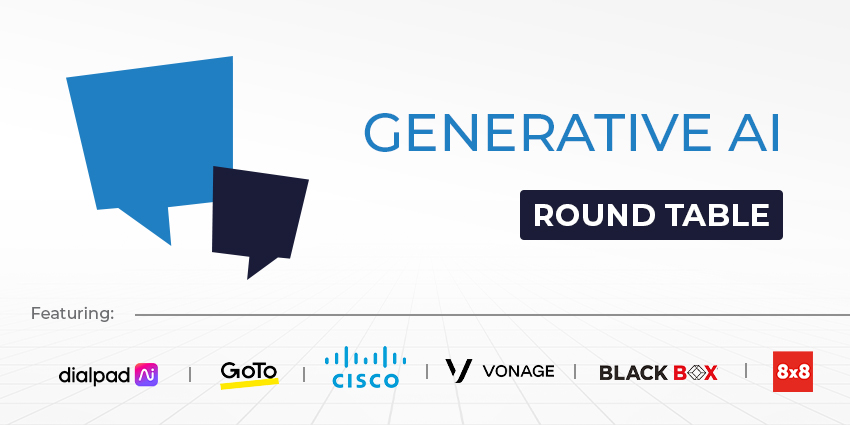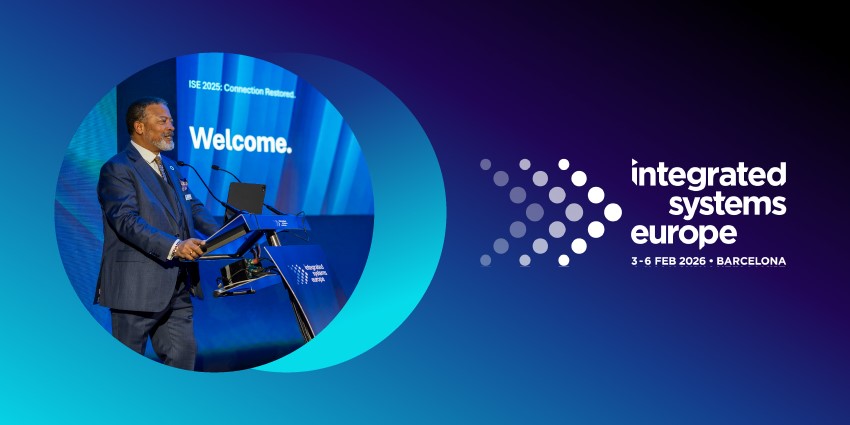To say generative AI is renovating the world of UC and collaboration would be an understatement. Organisations around the globe are leveraging Gen AI to drive innovative solutions that boost productivity and streamline workflows. By automating routine tasks, facilitating real-time language translation, and personalising user experiences, AI is already transforming how teams interact and collaborate across platforms.
With our latest Round Table subject, “Generative AI”, we spoke with experts and executives from Dialpad, GoTo, Cisco, Vonage, Black Box and 8×8 about the most compelling 2024 trends around Gen AI in UC&C, the challenges in intergrating Gen AI within existing systems and the best practices for adoption, strategies to address ethical concerns around Gen AI’s impact on data privacy and security, and what the future holds for Gen AI in UC&C.
What are the most compelling 2024 trends around Gen AI’s utilisation in UC and collaboration?

Justin Powell, RVP Partner Sales EMEA at Dialpad
Powell noted a permanent shift in how we work, communicate, and collaborate, which has caused organisations to become fed up with dominant communication platforms that have taken a reactive approach to AI adoption.
“Instead of disparate, bolted-on services, there has been an increased demand for purpose-built, industry-specific AI assistants that can provide highly relevant, contextual support,” Powell said.
“By treating AI as a force multiplier for human capabilities rather than a replacement, organisations can create an AI-enhanced ecosystem that supports and amplifies human strengths, ultimately delivering superior experiences for both employees and customers – we believe Dialpad is at the forefront of this.”

Damon Covey, General Manager, UCC at GoTo
Covey observed that one of the most significant trends in the UC&C space this year has been the adoption of generative AI in the contact centre.
“Organisations are eager to capitalise on their growing potential to make agents, IT teams, and supervisors more productive and improve customer interactions,” Covey stated. “While thoughtful implementation is still required, tech leaders also see AI as a fix for some of the pain points that human employees are facing, enabling things like customer sentiment to be more easily quantified and analysed.”
Covey elaborated by pointing out that Generative AI and AI sentiment analysis also give teams the resources to be more productive and faster.
“For instance, generative AI can assist employees by quickly providing customer information, records, and related materials to facilitate service and speed up resolution times,” he added. “The same is true for new employees – businesses can more quickly get them onboarded, trained, and ready with generative AI able to provide information and answer questions in real-time.”
Savinay Berry, CTO and Head of Strategy and Technology at Vonage
Berry argued that Generative AI is transforming UC by automating and enhancing how teams collaborate.
“We’re seeing AI tools elevate customer service and internal workflows by facilitating more natural, contextually aware conversations across platforms,” he continued. “Tools like virtual agents, chatbots and real-time transcription have become essential in allowing teams to communicate and collaborate more easily.”
Berry explained that AI’s ability to analyse interactions and provide personalised responses in real time is helping drive increased productivity. Its integration into UC systems is also streamlining processes such as transcription, translation, and customer engagement.
“This automation not only fosters better collaboration and agility but also enhances visibility, allowing businesses to make more informed decisions,” Berry said. “The combination of AI and UC is making processes, in general, faster while also making them smarter.”
Ben Receveur, Director of Product and Solution Architecture, Modern Workplace Technologies at Black Box
Receveur, likewise, asserted that the integration of AI into UC&C systems promises to make global collaboration more seamless and productive by breaking down language barriers, enhancing meeting efficiency, and automating routine tasks.
“A key trend in the integration of AI into UC&C is the development of real-time language support, which enables effective conference calls between participants speaking different languages,” Receveur said. “This breakthrough will significantly enhance communication for global organisations, eliminating the need for translators and allowing for more natural, fluid conversations.”
Another important trend Receveur highlighted is the evolution of virtual assistants.
“These AI-powered tools will be capable of distilling lengthy meetings into concise notes and action items, saving time for professionals who can’t always review full recordings,” he added. “Additionally, collaboration tools are advancing to leverage AI for content creation, automatically drafting emails and presentations based on meeting outcomes. This automation of tasks is expected to boost productivity and streamline workflows.”
Jonathan McKenzie, Senior AI Contact Centre Product Manager at 8×8
McKenzie highlighted that Gen AI has quickly become a leading solution in UC and collaboration because more organisations seek tools to improve user experience and boost efficiency amid long wait times, with use cases evolving at record speed.
“When this all launched, it primarily supported the creation of written content,” McKenzie said. “However, some of the new models coming out support images, videos, audio and code. Generative AI is changing the workplace and improving customer and employee experiences, this technology will only continue to increase its value to the workplace.”
“Platforms like ChatGPT, a combination of conversational and Gen AI, are rapidly reshaping customer services for both agents and customers,” McKenzie added. “For example, Gen AI is known to make workflows much more efficient, with 87 percent of IT leaders recognising its role in enhancing overall productivity. By handling routine tasks, Gen AI frees up time for human agents to concentrate their efforts on building rapport and an emotional connection with customers.”
McKenzie also underlined that Gen AI’s ability to analyse large data sets, provide real-time insights and summarise information from resources like documents, emails, and call or video transcripts, helps contact centres become more agile and proactive in meeting changing customer needs.
“In fact, 74 percent of internet users prefer to interact with chatbots for straightforward queries,” he said. “This technology not only reduces wait times but also takes the customer journey to the next level by offering personalised recommendations and actions in real time.”
Keith Griffin, Cisco Fellow, Site Leader for Cisco Galway
Griffin suggests that one of the most exciting trends in 2024, which Cisco introduced at Webex One last year, is the rise of multimodal AI, particularly in UC and collaboration spaces.
“Generative AI’s ability to seamlessly work across multiple communication channels, whether text, audio, video, or images, is transforming how we connect and collaborate,” he elaborated.
“This trend is especially compelling because it allows AI to engage in richer, more diverse forms of communication, adapting to different mediums and even languages. By integrating these capabilities into UC platforms like Webex, teams can collaborate more effectively, enhancing productivity and innovation. This shift towards a more comprehensive, AI-powered communication model is one of the most significant advancements we’ve seen.”
What challenges are you seeing in integrating generative AI with existing UC systems and infrastructure, and what technologies or best practices do you recommend organisations adopt for overcoming them?

Keith Griffin, Cisco Fellow, Site Leader for Cisco Galway
Griffin suggested the challenges in integrating Gen AI with existing UC systems are primarily non-technical.
“Technically, we can develop the right AI features tailored to make a real impact, and we’re seeing strong adoption,” Griffin continued. “However, non-technical challenges such as uncertainty among stakeholders, lack of deployment processes for AI, and communication gaps are significant barriers.”
Griffin observed that organisations may struggle to align AI’s role within their broader strategy, and clear processes are needed to ensure responsible AI use. He maintained that transparency is crucial for smooth transitions and practical implementations.
“One key recommendation is to adopt an open, flexible approach to AI,” Griffin said. “Our design approach has been to apply the most suitable AI models to solve a given problem and not to be locked to any one model. This end-to-end flexibility ensures that AI solutions can be optimised for diverse needs while maintaining transparency and adaptability.”

Jonathan McKenzie, Senior AI Contact Centre Product Manager at 8×8
McKenzie underscored that while the advantages of Gen AI are clear, the potential risks should not be overlooked.
“Firstly, trusting AI with sensitive information requires bulletproofing your data security measures,” McKenzie said. “A single mistake can lead to significant repercussions, making it essential for businesses to maintain consistent and strict data oversight.”
“Secondly, despite Gen AI’s ability to answer questions in human-like language, its responses can, on occasion, have bias or errors. For instance, before the recent UK election, voters were recommended fake AI-generated videos featuring party leaders, misinformation, and clips with abusive comments. When not trained properly, chatbots can go as far as to swear at customers. This stresses the need for vigilant monitoring and filtering to prevent harm.”
McKenzie argued that training the system is the first step to overcoming these challenges. As with any technology implementation, he said that knowing an organisation’s end goal is crucial—the specific task it wants to perform, the data it can access, the testing duration, filters, company system access, and the quality of existing systems for integration and learning.
“Think of generative AI like a student who is constantly studying and learning,” McKenzie said. “The student’s understanding depends on the quality of the lessons and books they study, AI learns from the data it’s given. If the information is inaccurate, incomplete, or biased, the student’s understanding will be off—and the same goes for Gen AI.”
McKenzie stressed that if history is accurate, the cost of LLM/Gen AI models will decrease as technology and compute power become cheaper, which means this technology will become even more available.
“Ultimately, maintaining human agents at the heart of operations is key,” McKenzie concluded. “By monitoring Gen AI’s use and outputs closely and subsequently refining the system based on customer feedback, businesses can improve the quality and reliability of their customer experience. AI will play a large part in this, but it needs human and business intelligence to truly succeed.”
Ben Receveur, Director of Product and Solution Architecture, Modern Workplace Technologies at Black Box
Receveur suggested a primary challenge in integrating generative AI with existing UC systems is the prevalence of outdated infrastructure.
“Many organisations are still relying on systems that are 20-30 years old and lack the capability to interface with modern AI technologies,” Receveur said. “This legacy tech debt makes integration complex and expensive. To address this, we advise organisations to invest in updating their infrastructure, whether through cloud-based UCaaS solutions or modern on-premises systems.”
“Another significant challenge is the complexity of AI, particularly in training models. Rather than investing heavily in developing proprietary AI models, we recommend that organisations partner with established AI providers that offer secure environments for training models on historical data.”
Additionally, Receveur outlined that shifting toward automation in support systems presents a key opportunity for business development.
“By implementing AI-powered chatbots and automated ticket systems, organisations can significantly reduce the manual workload associated with system changes and support requests,” he added. “This overall approach allows companies to leverage AI capabilities without substantial investment in AI development.”
Damon Covey, General Manager, UCC at GoTo
Covey affirmed that organisations looking to implement generative AI should first and foremost consider its interoperability with their existing tech stack.
“Modern, cloud-based UC systems often make this process easy, but for companies that still rely on outdated or legacy UC solutions, it can be difficult, if not impossible, to fully integrate the AI solution and provide it with access to the range of data required for it to deliver on its full value,” Covey explained.
In a broader sense, Covey suggested organisations also need to consider concerns around security, ethics, regulations, and unintentional biases when implementing AI. UC and collaboration systems generate large amounts of data, both from a business’ own operations and from customer interactions.
“Is that data being properly safeguarded, and is the business following all applicable regulations in how it collects and stores that information?” Covey continued. “With generative AI becoming especially popular in the UC industry, companies will need to be hyper-focused on remaining compliant and reining in both unethical and unsanctioned use cases.”
Savinay Berry, CTO and Head of Strategy and Technology at Vonage
Berry stated that ensuring compatibility while maintaining high performance and robust security can be a challenge for businesses.
“Many legacy systems were not designed with AI in mind, leading to inflexibility when trying to integrate advanced AI-driven solutions,” Berry said. “To overcome this, organisations should consider moving toward cloud-based architectures and leveraging flexible APIs that allow seamless integration of AI without needing to overhaul their entire infrastructure.”
“Another critical concern is security and compliance,” continued, “particularly in sectors handling sensitive data, such as healthcare and finance. Ensuring data privacy while scaling AI functionalities requires strict adherence to regulations like GDPR, and organisations should implement strong encryption and monitoring protocols. Investing in AI tools that prioritise both security and scalability will help businesses manage these challenges effectively.”
Justin Powell, RVP Partner Sales EMEA at Dialpad
Powell argued that the biggest challenge is ensuring AI models have access to accurate, up-to-date data and can integrate seamlessly with existing workflows.
“Organisations should focus on building a robust data foundation and API infrastructure to connect their AI and UC systems,” Powell said. “Investing in data quality to develop AI solutions that are natively integrated into the communication platform, rather than bolt-on tools, is critical to ensure a seamless user experience.”
What strategies would you advise organisations introduce to address ethical concerns around data privacy and security when using Gen AI in communication tools?

Savinay Berry, CTO and Head of Strategy and Technology at Vonage
Berry asserted that organisations should consider data privacy, transparency and security first.
“One essential strategy is ensuring that AI tools are trained on secure and compliant datasets, adhering to regulations like GDPR,” Berry suggested. “Anonymising data and adopting clear data governance policies can help mitigate the risk of exposing sensitive information.”
“Transparency is also key, and organisations need to clearly communicate how data is being collected, used and processed. Implementing robust monitoring systems to track AI interactions and flag potential issues early is another best practice.”
To address ethical concerns, Berry outlined that AI should be developed with privacy-first principles. “This can foster trust while enabling businesses to reap the benefits of AI without compromising sensitive customer or business information,” he explained. “Organisations should also conduct regular audits to ensure everything is running smoothly and to build trust.”
Justin Powell, RVP Partner Sales EMEA at Dialpad
In addition to working with trustworthy AI vendors, Powell highlighted that organisations need to prioritise transparency and give users control over how their data is used to train AI models.
“Strong data governance policies with encryption and access controls should be implemented, as well as clear communications around what data is collected and how it’s used,” he expanded.
Keith Griffin, Cisco Fellow, Site Leader for Cisco Galway
For Griffin, addressing ethical concerns around data privacy and security means organisations should adopt a multi-layered strategy that aligns with regional and jurisdictional regulations. He stressed that as AI legislation continues to evolve globally, it’s crucial for businesses to stay compliant with local regulations.
“One key strategy is implementing clear policy protocols that customers can trust,” Griffin said. “If a company doesn’t have its own framework, it can adapt established frameworks from trusted sources to suit its specific needs.”
“Additionally, organisations should ensure their strategies align with compliance standards and leverage existing materials instead of starting from scratch. Utilising a trusted framework based on principles like transparency, fairness, and security helps foster confidence among stakeholders and customers while mitigating privacy risks.”
Damon Covey, General Manager, UCC at GoTo
Covey noted two key strategies around compliance.
“First, it’s important to be aware of any regulations dictating how data is used, such as the EU’s AI Act,” he explained. “These are not just ethical but legal parameters for frameworks that should guide how AI providers collect, use, and store data.”
Additionally, Covey clarified that businesses must take steps to minimise and anonymise data collection and clearly communicate these policies to customers. “That means companies only collect data that is required for their AI solutions to perform and improve, rather than gathering large swaths of information, and this data is automatically anonymised to protect the identities or personal information of the individual who provided it,” Covey elaborated.
Ben Receveur, Director of Product and Solution Architecture, Modern Workplace Technologies at Black Box
Receveur outlined that Black Box advises organisations to implement a multifaceted approach that not only protects sensitive information but also ensures compliance with ethical standards and maintains trust with customers and stakeholders.
“First, organisations need to anonymise personal data before it enters any AI model,” Receveur continued. “This crucial process ensures that sensitive information is protected and not inadvertently shared or learned by the AI system. Organisations must also be discerning about the AI models they use, avoiding public models like ChatGPT for sensitive business data to prevent unintended data exposure.”
Receveur added that companies should develop a comprehensive ethical framework for AI usage that aligns with their business objectives and values. This framework should guide all AI-related decisions and implementations.
“For instance, when partnering with AI providers, it’s vital to choose those whose ethical standards align with the organisation’s established framework,” he illustrated. “Meanwhile, performing routine security audits will be essential to maintaining robust data protection measures. By adhering to these strategies, companies can mitigate risks associated with data privacy and security while leveraging the benefits of AI in their communication tools.”
What role do you see generative AI playing in the future of unified communications and collaboration platforms?

Ben Receveur, Director of Product and Solution Architecture, Modern Workplace Technologies at Black Box
Receveur foretold that as AI continues to evolve, it will increasingly automate routine tasks, enhance personalisation, and provide intelligent support across various aspects of unified communications and collaboration platforms.
“Generative AI will significantly enhance automation in day-to-day operations, including moves, adds, changes, and deletions (MACDs), as well as in addressing service issues,” he added.
Receveur stressed that AI will enable increasingly personalised experiences. It will learn individual preferences for tasks such as meeting summaries and adapt its output accordingly. Receveur predicted that personalisation will extend to supporting hybrid work environments, with AI systems recognising and adapting to different work settings and devices used by individuals.
“In the IT realm, AI chatbots integrated into collaboration tools like Microsoft Teams will be capable of diagnosing and resolving technical issues automatically, streamlining support processes,” he suggested. “The integration of AI into UC&C will blur the lines between communication tools and broader IT infrastructure, recognising that issues in one area can impact the other. This holistic approach will lead to more seamless, efficient, and user-friendly communication and collaboration experiences.”
Damon Covey, General Manager, UCC at GoTo
Covey recalled that in its early stages, AI provided the most value by augmenting the way employees and existing solutions worked within a business. With the rapid acceleration in AI developments and availability of new AI solutions, however, Covey outlined that we are on the cusp of a new wave that will fundamentally transform the ways employees work and communicate.
“When applied to improving the customer communications experience, for example, AI-powered chatbots can engage with customers to provide answers at any time of day, providing real-time support even when agents are offline or unavailable,” he said.
“When interactions are being managed by a human agent, generative AI can also provide employees with the customer’s full history, product usage, and other information to offer a more personalised experience, making customers feel understood and valued. These are just a few examples, and we will doubtless see valuable new applications as AI continues to evolve, becoming a true force multiplier for businesses.”
Justin Powell, RVP Partner Sales EMEA at Dialpad
Powell asserted that generative AI will be a core part of UC platforms, acting as an intelligent assistant that boosts productivity, unleashes creativity, and forges high-performance teams.
“Employees will be able to focus on building meaningful relationships with customers and make strategic decisions, while AI handles the heavy lifting of information processing and analysis, ultimately driving better business outcomes,” Powell said.
“We at Dialpad are leading this transformation with our native AI capabilities, which have been trained on over seven billion minutes of data from business conversations, allowing us to deliver real-time insights, coaching, and automation that enhance every customer interaction and internal collaboration.”
Keith Griffin, Cisco Fellow, Site Leader for Cisco Galway
Griffin signalled that in areas like contact centres and customer experience, AI offers the potential to solve long-standing challenges.
“From predictive technologies to virtual agents, AI can significantly improve interactions, making them more efficient and personalised,” he said. “After over a decade of minimal change in contact centre design, generative AI can drive meaningful improvements, benefiting both agents and customers.”
“By automating routine tasks and providing real-time insights, AI can enhance the experience for everyone involved, making communication smoother, faster, and more effective,” Griffin continued. “This evolution will ultimately reshape how organisations collaborate and engage with customers and agents.”
Savinay Berry, CTO and Head of Strategy and Technology at Vonage
Berry emphasised that generative AI will play an increasingly central role in UC, acting as the backbone for more intuitive and personalised collaboration all around.
“AI will act as a co-pilot, providing teams with actionable insights and automating processes that would otherwise consume significant resources and time,” he foretold.
“In the future, UC platforms will evolve into dynamic ecosystems where AI enhances productivity by anticipating needs and enabling faster, more seamless collaboration in what is expected to get even closer to a human-like level,” Berry concluded. “This shift will empower teams to focus on higher-value tasks, leaving the repetitive and administrative work to AI, a partner that can help foster a better connected and responsive environment for all.”







